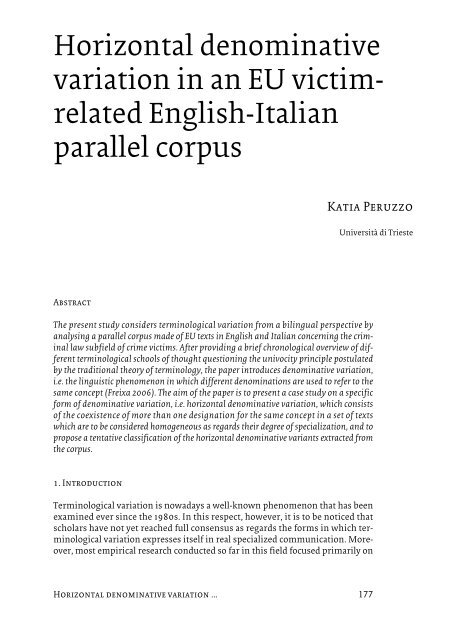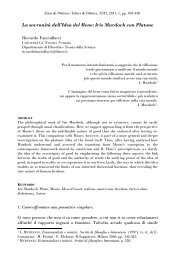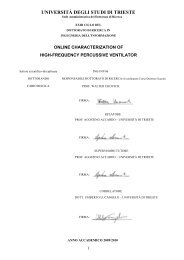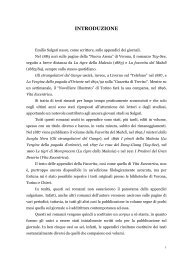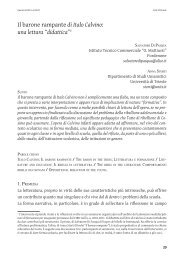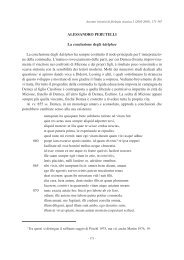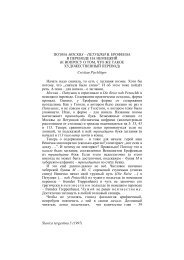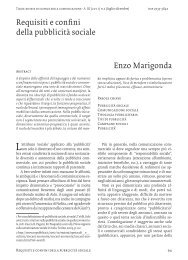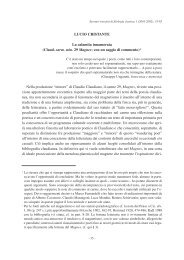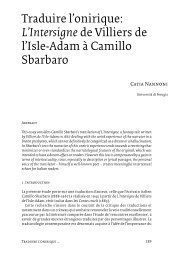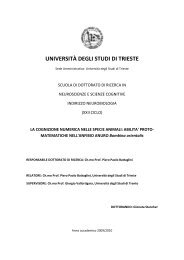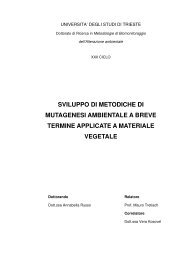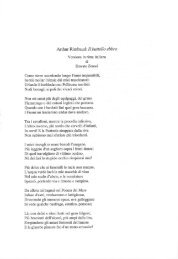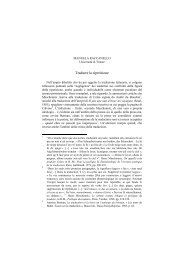Horizontal denominative variation in an EU victim ... - OpenstarTs
Horizontal denominative variation in an EU victim ... - OpenstarTs
Horizontal denominative variation in an EU victim ... - OpenstarTs
Create successful ePaper yourself
Turn your PDF publications into a flip-book with our unique Google optimized e-Paper software.
<strong>Horizontal</strong> <strong>denom<strong>in</strong>ative</strong><br />
<strong>variation</strong> <strong>in</strong> <strong>an</strong> <strong>EU</strong> <strong>victim</strong>related<br />
English-Itali<strong>an</strong><br />
parallel corpus<br />
Katia Peruzzo<br />
Università di Trieste<br />
Abstract<br />
The present study considers term<strong>in</strong>ological <strong>variation</strong> from a bil<strong>in</strong>gual perspective by<br />
<strong>an</strong>alys<strong>in</strong>g a parallel corpus made of <strong>EU</strong> texts <strong>in</strong> English <strong>an</strong>d Itali<strong>an</strong> concern<strong>in</strong>g the crim<strong>in</strong>al<br />
law subfield of crime <strong>victim</strong>s. After provid<strong>in</strong>g a brief chronological overview of different<br />
term<strong>in</strong>ological schools of thought question<strong>in</strong>g the univocity pr<strong>in</strong>ciple postulated<br />
by the traditional theory of term<strong>in</strong>ology, the paper <strong>in</strong>troduces <strong>denom<strong>in</strong>ative</strong> <strong>variation</strong>,<br />
i.e. the l<strong>in</strong>guistic phenomenon <strong>in</strong> which different denom<strong>in</strong>ations are used to refer to the<br />
same concept (Freixa 2006). The aim of the paper is to present a case study on a specific<br />
form of <strong>denom<strong>in</strong>ative</strong> <strong>variation</strong>, i.e. horizontal <strong>denom<strong>in</strong>ative</strong> <strong>variation</strong>, which consists<br />
of the coexistence of more th<strong>an</strong> one designation for the same concept <strong>in</strong> a set of texts<br />
which are to be considered homogeneous as regards their degree of specialization, <strong>an</strong>d to<br />
propose a tentative classification of the horizontal <strong>denom<strong>in</strong>ative</strong> vari<strong>an</strong>ts extracted from<br />
the corpus.<br />
1. Introduction<br />
Term<strong>in</strong>ological <strong>variation</strong> is nowadays a well-known phenomenon that has been<br />
exam<strong>in</strong>ed ever s<strong>in</strong>ce the 1980s. In this respect, however, it is to be noticed that<br />
scholars have not yet reached full consensus as regards the forms <strong>in</strong> which term<strong>in</strong>ological<br />
<strong>variation</strong> expresses itself <strong>in</strong> real specialized communication. Moreover,<br />
most empirical research conducted so far <strong>in</strong> this field focused primarily on<br />
<strong>Horizontal</strong> <strong>denom<strong>in</strong>ative</strong> <strong>variation</strong> ... 177
monol<strong>in</strong>gual texts, as the st<strong>an</strong>dpo<strong>in</strong>t from which the phenomenon was exam<strong>in</strong>ed<br />
was ma<strong>in</strong>ly term<strong>in</strong>ological. In l<strong>in</strong>e with the m<strong>in</strong>ority of scholars tackl<strong>in</strong>g<br />
the specific phenomenon of term<strong>in</strong>ological <strong>variation</strong> from a contrastive po<strong>in</strong>t<br />
of view (cf. for example Merkel 1998, Rogers 2004, Rogers 2008) <strong>an</strong>d unlike<br />
ma<strong>in</strong>stream research, the purpose of the present study is to take <strong>in</strong>to consideration<br />
a parallel corpus made of Europe<strong>an</strong> Union texts deal<strong>in</strong>g with the crim<strong>in</strong>al<br />
law subfield related to the role of the <strong>victim</strong> <strong>in</strong> crim<strong>in</strong>al proceed<strong>in</strong>gs <strong>in</strong> two l<strong>an</strong>guages,<br />
English <strong>an</strong>d Itali<strong>an</strong>, <strong>in</strong> order to verify – from a tr<strong>an</strong>slational viewpo<strong>in</strong>t –<br />
the presence of a s<strong>in</strong>gle aspect of term<strong>in</strong>ological <strong>variation</strong>, i.e. <strong>denom<strong>in</strong>ative</strong><br />
<strong>variation</strong>.<br />
The paper is structured as follows: Section 2 presents a brief chronological<br />
overview of different term<strong>in</strong>ological schools of thought question<strong>in</strong>g the univocity<br />
pr<strong>in</strong>ciple postulated by the traditional theory of term<strong>in</strong>ology; Section 3<br />
<strong>in</strong>troduces the concept of <strong>denom<strong>in</strong>ative</strong> <strong>variation</strong>; Section 4 describes the case<br />
study on a specific form of <strong>variation</strong>, i.e. horizontal <strong>denom<strong>in</strong>ative</strong> <strong>variation</strong>;<br />
Section 5 concludes the paper <strong>an</strong>d suggests what future work should address.<br />
2. From monosemy to polysemy <strong>an</strong>d synonymy<br />
The birth of term<strong>in</strong>ology as a discipl<strong>in</strong>e dates back to the 1930s, when specialized<br />
lexicographic work was performed by subject field experts, must prom<strong>in</strong>ently<br />
by eng<strong>in</strong>eers such as Wüster, the developer of what is now considered<br />
the traditional term<strong>in</strong>ology theory, <strong>in</strong> order to meet the need for st<strong>an</strong>dardization<br />
of the pr<strong>in</strong>ciples <strong>an</strong>d methods used <strong>in</strong> term<strong>in</strong>ology m<strong>an</strong>agement, thus suggest<strong>in</strong>g<br />
<strong>an</strong> overall prescriptive approach to the term<strong>in</strong>ological discipl<strong>in</strong>e.<br />
The result<strong>in</strong>g st<strong>an</strong>dardization activity, which differentiates itself from traditional<br />
lexicographic work because of its object of study – terms rather th<strong>an</strong><br />
words – <strong>an</strong>d of its onomasiological rather th<strong>an</strong> semasiological approach,<br />
focused on the compilation of repositories of term<strong>in</strong>ological data – subject field<br />
concepts <strong>an</strong>d their designations – <strong>in</strong>tended to normalize exist<strong>in</strong>g terms so as to<br />
elim<strong>in</strong>ate ambiguities <strong>an</strong>d assure unambiguous, effective <strong>an</strong>d efficient communication<br />
among subject-field professionals. In order to consider terms from<br />
such a l<strong>an</strong>guage pl<strong>an</strong>n<strong>in</strong>g perspective, they necessarily need to fulfill the socalled<br />
univocity pr<strong>in</strong>ciple, accord<strong>in</strong>g to which there is a one-to-one relationship<br />
between a concept <strong>an</strong>d the term designat<strong>in</strong>g it, as synonymy <strong>an</strong>d polysemy are<br />
l<strong>in</strong>guistic phenomena to be avoided <strong>in</strong> specialized communication: a st<strong>an</strong>dpo<strong>in</strong>t<br />
shared not only by the Wüsteri<strong>an</strong> Vienna school, but also by the Prague<br />
<strong>an</strong>d the Soviet school.<br />
However, term<strong>in</strong>ological <strong>variation</strong> is <strong>an</strong> observable l<strong>in</strong>guistic phenomenon<br />
<strong>an</strong>d Wüster (1979) himself did not deny the existence of synonyms with<strong>in</strong> l<strong>in</strong>guistic<br />
communities work<strong>in</strong>g <strong>in</strong> the same field of knowledge, although he considered<br />
them a d<strong>an</strong>ger compromis<strong>in</strong>g effective communication. The first<br />
br<strong>an</strong>ch of term<strong>in</strong>ology to accept <strong>an</strong>d try to cope with term<strong>in</strong>ological <strong>variation</strong>,<br />
albeit always with<strong>in</strong> a st<strong>an</strong>dardiz<strong>in</strong>g approach, was developed <strong>in</strong> Quebec <strong>in</strong> the<br />
1980s (cf. for example Duquet-Picard 1983, Duquet-Picard 1986, Auger 1994):<br />
C<strong>an</strong>adi<strong>an</strong> term<strong>in</strong>ologists adopted a sociol<strong>in</strong>guistic perspective from which vari-<br />
178
ation <strong>in</strong> term<strong>in</strong>ology usage had necessarily to be taken <strong>in</strong>to account, although<br />
the need for st<strong>an</strong>dardization still prevailed.<br />
In the same period, tr<strong>an</strong>slation studies scholars also started express<strong>in</strong>g some<br />
<strong>in</strong>terest <strong>in</strong> the phenomena of polysemy <strong>an</strong>d synonymy, as proved by the<br />
acknowledgement of polysemy as a fundamental device among available techniques<br />
for the purpose of assign<strong>in</strong>g a l<strong>in</strong>guistic denom<strong>in</strong>ation to a concept<br />
through similarities with other already designated concepts (cf. Sager et al.<br />
1980: 78) <strong>an</strong>d by the follow<strong>in</strong>g statement: “a term may have several expression<br />
forms accord<strong>in</strong>g to the number of different text types <strong>in</strong> which it occurs” (Sager<br />
et al. 1980: 231). As far as synonymy is concerned, the authors also notice that<br />
“absolute cognitive synonymy is common <strong>in</strong> socially diversified special l<strong>an</strong>guages<br />
but is text type bound <strong>an</strong>d therefore not available for free <strong>variation</strong>”<br />
(Sager et al. 1980: 232).<br />
A further development towards the full recognition of term<strong>in</strong>ological <strong>variation</strong><br />
is represented by the so-called Socioterm<strong>in</strong>ology (cf. for example Gaud<strong>in</strong><br />
1993, Boul<strong>an</strong>ger 1995), founded <strong>in</strong> Fr<strong>an</strong>ce <strong>in</strong> the mid 1990s. Accord<strong>in</strong>g to scholars<br />
follow<strong>in</strong>g this approach, traditional term<strong>in</strong>ology theory failed to consider<br />
the usage of term<strong>in</strong>ology <strong>in</strong> real l<strong>an</strong>guage, <strong>in</strong>tended <strong>in</strong> the Saussuri<strong>an</strong> sense of<br />
parole, <strong>an</strong>d the social factors affect<strong>in</strong>g specialized communication, not recogniz<strong>in</strong>g<br />
that term<strong>in</strong>ology is a social science <strong>an</strong>d should therefore satisfy social needs.<br />
Socioterm<strong>in</strong>ology thus constitutes a descriptive approach which questions the<br />
traditional <strong>an</strong>d utopi<strong>an</strong> ideal of monosemy <strong>an</strong>d implies the study of real l<strong>an</strong>guage<br />
usage, compris<strong>in</strong>g term<strong>in</strong>ological <strong>variation</strong>.<br />
In the 1990s, Cabré <strong>an</strong>d the IULATERM group developed the so-called Communicative<br />
Theory of Term<strong>in</strong>ology (cf. Cabré 1999), which criticizes the traditional<br />
term<strong>in</strong>ology theory for not be<strong>in</strong>g able to recognize the communicative<br />
<strong>an</strong>d discourse aspects of terms nor formal or conceptual term<strong>in</strong>ological <strong>variation</strong>,<br />
thus giv<strong>in</strong>g rise to the establishment of a ma<strong>in</strong>ly prescriptive practical<br />
method which traditional term<strong>in</strong>ology theory considered valid <strong>in</strong> <strong>an</strong>y k<strong>in</strong>d of<br />
research, regardless of the subject field, the aims, the context <strong>in</strong> which the work<br />
is performed or the l<strong>in</strong>guistic type (Cabré 2000: 39-40). In the same article,<br />
Cabré also states that it is impossible to defend the univocity pr<strong>in</strong>ciple when<br />
observ<strong>in</strong>g the behaviour of term<strong>in</strong>ological units <strong>in</strong> real texts: the term<strong>in</strong>ology<br />
used is <strong>in</strong>evitably subject to <strong>variation</strong> accord<strong>in</strong>g to different parameters, which<br />
are the same parameters determ<strong>in</strong><strong>in</strong>g the <strong>variation</strong> of lexical units <strong>in</strong> general<br />
l<strong>an</strong>guage, as term<strong>in</strong>ology is simply a form of specialized communication with<strong>in</strong><br />
<strong>an</strong> exist<strong>in</strong>g l<strong>an</strong>guage.<br />
The question<strong>in</strong>g of the dogmatic monosemy postulated by traditional term<strong>in</strong>ology<br />
cont<strong>in</strong>ued <strong>in</strong>to the early years of the new millennium, with Temmerm<strong>an</strong><br />
(cf. Temmerm<strong>an</strong> 2000) propos<strong>in</strong>g the Sociocognitive approach, accord<strong>in</strong>g<br />
to which models for the description of l<strong>in</strong>guistic creativity, <strong>in</strong>clud<strong>in</strong>g term<strong>in</strong>ological<br />
<strong>variation</strong> <strong>in</strong> terms of synonymy <strong>an</strong>d polysemy, need to be developed <strong>in</strong><br />
order to <strong>an</strong>alyze real specialized l<strong>an</strong>guage <strong>in</strong> context both from a synchronic<br />
<strong>an</strong>d a diachronic perspective.<br />
<strong>Horizontal</strong> <strong>denom<strong>in</strong>ative</strong> <strong>variation</strong> ... 179
3 From polysemy <strong>an</strong>d synonymy to <strong>denom<strong>in</strong>ative</strong> <strong>variation</strong><br />
In the previous section the shift from traditional, polysemiophobic <strong>an</strong>d<br />
homonymiphobic term<strong>in</strong>ological approach (cf. Temmerm<strong>an</strong> 2000: 68) towards<br />
different real l<strong>an</strong>guage-oriented perspectives has been outl<strong>in</strong>ed very briefly. It<br />
goes without say<strong>in</strong>g that, based on the evidence provided above, term<strong>in</strong>ological<br />
<strong>variation</strong> is nowadays a well-known phenomenon, r<strong>an</strong>g<strong>in</strong>g from morphological<br />
<strong>an</strong>d morpho-syntactic to sem<strong>an</strong>tic <strong>variation</strong>: the purpose of the present study is<br />
to give further evidence of the existence of a specific aspect of term<strong>in</strong>ological<br />
<strong>variation</strong>, namely <strong>denom<strong>in</strong>ative</strong> <strong>variation</strong>.<br />
Before exam<strong>in</strong><strong>in</strong>g the m<strong>an</strong>ifestation of this l<strong>in</strong>guistic phenomenon <strong>in</strong> real<br />
communication, it is necessary to def<strong>in</strong>e the terms term<strong>in</strong>ological <strong>variation</strong> <strong>an</strong>d<br />
denotative <strong>variation</strong>. One of the first authors to deal with the concept of term<strong>in</strong>ological<br />
<strong>variation</strong> <strong>in</strong> French is Corbeil, accord<strong>in</strong>g to whom term<strong>in</strong>ological <strong>variation</strong><br />
comprises both synonymy, which he calls “concurrence term<strong>in</strong>ologique”<br />
(Corbeil 1988: 57, cited <strong>in</strong> Freixa 2002: 53), <strong>an</strong>d polysemy. Almost a decade later,<br />
Daille et al. (1996: 201) provided the follow<strong>in</strong>g def<strong>in</strong>ition: “a vari<strong>an</strong>t of a term is<br />
<strong>an</strong> utter<strong>an</strong>ce which is sem<strong>an</strong>tically <strong>an</strong>d conceptually related to <strong>an</strong> orig<strong>in</strong>al<br />
term”. In their view, a vari<strong>an</strong>t is therefore <strong>an</strong>y attested form of a designation of a<br />
specific concept encountered <strong>in</strong> a text, different from <strong>an</strong> authorized term listed<br />
<strong>in</strong> <strong>an</strong> authoritative resource <strong>an</strong>d reflect<strong>in</strong>g a different degree of sem<strong>an</strong>tic or<br />
conceptual identity or dist<strong>an</strong>ce with the “orig<strong>in</strong>al” term. Consequently, the def<strong>in</strong>ition<br />
proposed by Daille et al. differs from Corbeil’s as term<strong>in</strong>ological <strong>variation</strong>,<br />
apart from synonymy <strong>an</strong>d polysemy, also <strong>in</strong>cludes cases of hypernymy <strong>an</strong>d<br />
hyponymy.<br />
In our view, term<strong>in</strong>ological <strong>variation</strong> should be <strong>in</strong>tended accord<strong>in</strong>g to Freixa’s<br />
broad def<strong>in</strong>ition “la variació que afecta els termes” (2002: 54). Provided that the<br />
existence of term<strong>in</strong>ological units is based on both semiotic or l<strong>in</strong>guistic <strong>an</strong>d<br />
conceptual aspects, we c<strong>an</strong> therefore assume that term<strong>in</strong>ological <strong>variation</strong><br />
<strong>in</strong>cludes two types of <strong>variation</strong>: <strong>denom<strong>in</strong>ative</strong> <strong>variation</strong>, def<strong>in</strong>ed by Freixa as “el<br />
fenomen pel qual a una mateixa noció li corresponen diverses denom<strong>in</strong>acions”,<br />
<strong>an</strong>d conceptual <strong>variation</strong>, me<strong>an</strong><strong>in</strong>g “variació en un mateix concepte” (Freixa 2002:<br />
54). The preference for the term <strong>denom<strong>in</strong>ative</strong> <strong>variation</strong>, further def<strong>in</strong>ed by the<br />
same author as “the phenomenon <strong>in</strong> which one <strong>an</strong>d the same concept has different<br />
denom<strong>in</strong>ations; […] restricted to <strong>variation</strong> among different denom<strong>in</strong>ations,<br />
i.e., lexicalized forms, with a m<strong>in</strong>imum of stability <strong>an</strong>d consensus among<br />
the users of units <strong>in</strong> a specialized doma<strong>in</strong>” (Freixa 2006: 51), over the term synonymy,<br />
is due to the purpose of avoid<strong>in</strong>g the much debated dist<strong>in</strong>ction between<br />
what is considered a proper synonym, i.e. a term designat<strong>in</strong>g the same concept<br />
as <strong>an</strong>other term <strong>in</strong> which one or more lexical elements constitut<strong>in</strong>g the unit differ<br />
from the latter, <strong>an</strong>d vari<strong>an</strong>ts, which are usually identified with terms present<strong>in</strong>g<br />
syntactic, morphosyntactic, morphological or orthographical modifications<br />
(abbreviations, acronyms, presence/absence of articles <strong>in</strong> multiword<br />
terms etc.).<br />
180
4 Empirical case study: <strong>denom<strong>in</strong>ative</strong> <strong>variation</strong> <strong>in</strong> <strong>victim</strong>-related term<strong>in</strong>ology<br />
The purpose of the study is to exam<strong>in</strong>e <strong>denom<strong>in</strong>ative</strong> <strong>variation</strong> with<strong>in</strong> <strong>EU</strong> texts<br />
that have undergone a tr<strong>an</strong>slation process that is “qualitatively different from<br />
tr<strong>an</strong>slation <strong>in</strong> other contexts due to the special character <strong>an</strong>d org<strong>an</strong>ization of the<br />
legal system” (Kjær 2007: 70). The result<strong>in</strong>g texts are not the product of tr<strong>an</strong>slation<br />
<strong>in</strong> the strict sense of the word, but rather of “<strong>in</strong>terl<strong>in</strong>gual text reproduction”<br />
(Kjær 2007: 87), a process <strong>in</strong> which tr<strong>an</strong>slators should reproduce “words<br />
<strong>an</strong>d phrases that c<strong>an</strong> ensure coherence <strong>an</strong>d consistency with<strong>in</strong> <strong>an</strong>d across the 23<br />
equally authentic l<strong>an</strong>guage versions” (Goddard 2009: 183). Consequently, as far<br />
as <strong>EU</strong> legislation is concerned, the texts result<strong>in</strong>g from <strong>in</strong>terl<strong>in</strong>gual reproduction<br />
are not to be considered tr<strong>an</strong>slations, but rather l<strong>an</strong>guage versions that fulfill<br />
the equal authenticity pr<strong>in</strong>ciple.<br />
To safeguard consistency form a term<strong>in</strong>ological perspective <strong>in</strong> all l<strong>an</strong>guage<br />
versions, Guidel<strong>in</strong>e 6 of the Jo<strong>in</strong>t Practical Guide of the Europe<strong>an</strong> Parliament,<br />
the Council <strong>an</strong>d the Commission for persons <strong>in</strong>volved <strong>in</strong> the draft<strong>in</strong>g of legislation<br />
with<strong>in</strong> the Community <strong>in</strong>stitutions, 1 adopted <strong>in</strong> 2003 by the three <strong>in</strong>stitutions<br />
<strong>in</strong> order to improve the quality of Community acts, states that “The term<strong>in</strong>ology<br />
used <strong>in</strong> a given act shall be consistent both <strong>in</strong>ternally <strong>an</strong>d with acts<br />
already <strong>in</strong> force, especially <strong>in</strong> the same field.” <strong>an</strong>d that “Identical concepts shall<br />
be expressed <strong>in</strong> the same terms, as far as possible without depart<strong>in</strong>g from their<br />
me<strong>an</strong><strong>in</strong>g <strong>in</strong> ord<strong>in</strong>ary, legal or technical l<strong>an</strong>guage” (Jo<strong>in</strong>t Practical Guide 2003:<br />
21).<br />
In its subsection 6.1, the same Guidel<strong>in</strong>e reads as follows:<br />
In order to aid comprehension <strong>an</strong>d <strong>in</strong>terpretation of a legislative act, the text must be<br />
consistent. A dist<strong>in</strong>ction c<strong>an</strong> be drawn between formal consistency, concern<strong>in</strong>g only<br />
questions of term<strong>in</strong>ology, <strong>an</strong>d subst<strong>an</strong>tive consistency, <strong>in</strong> a broader sense, concern<strong>in</strong>g<br />
the logic of the act as a whole. (Jo<strong>in</strong>t Practical Guide 2003: 21)<br />
<strong>an</strong>d provides a def<strong>in</strong>ition for formal consistency <strong>in</strong> subsection 6.2:<br />
Consistency of term<strong>in</strong>ology me<strong>an</strong>s that the same terms are to be used to express the<br />
same concepts <strong>an</strong>d that identical terms must not be used to express different concepts.<br />
The aim is to leave no ambiguities, contradictions or doubts as to the me<strong>an</strong><strong>in</strong>g<br />
of a term. Any given term is therefore to be used <strong>in</strong> a uniform m<strong>an</strong>ner to refer to the<br />
same th<strong>in</strong>g <strong>an</strong>d <strong>an</strong>other term must be chosen to express a different concept. (Jo<strong>in</strong>t<br />
Practical Guide 2003: 21)<br />
It is subsequently (subsection 6.2.1) specified that formal consistency should be<br />
ensured not only with<strong>in</strong> a s<strong>in</strong>gle act, but also with<strong>in</strong> the broader framework of<br />
exist<strong>in</strong>g legislation:<br />
This applies not only to the provisions of a s<strong>in</strong>gle act, <strong>in</strong>clud<strong>in</strong>g the <strong>an</strong>nexes, but also<br />
to provisions of related acts, <strong>in</strong> particular implement<strong>in</strong>g acts <strong>an</strong>d all other acts <strong>in</strong> the<br />
same area. In general, term<strong>in</strong>ology must be consistent with the legislation <strong>in</strong> force.<br />
(Jo<strong>in</strong>t Practical Guide 2003: 21)<br />
1 Available at http://eur-lex.europa.eu/en/techleg/pdf/en.pdf (last visited: August 2010).<br />
<strong>Horizontal</strong> <strong>denom<strong>in</strong>ative</strong> <strong>variation</strong> ... 181
The need for “better lawmak<strong>in</strong>g by clearer, simpler acts comply<strong>in</strong>g with pr<strong>in</strong>ciples<br />
of good legislative draft<strong>in</strong>g” (Jo<strong>in</strong>t Practical Guide 2003: 5) has been<br />
expressed s<strong>in</strong>ce the Ed<strong>in</strong>burgh Europe<strong>an</strong> Council <strong>in</strong> 1992 <strong>an</strong>d <strong>in</strong>itial steps to<br />
meet it were taken with the Council Resolution of 8 June 1993 on the quality of<br />
draft<strong>in</strong>g of Community legislation. This Resolution led to the adoption of the<br />
Inter<strong>in</strong>stitutional Agreement of 22 December 1998 on common guidel<strong>in</strong>es for<br />
the quality of draft<strong>in</strong>g of Community legislation 2 of which the above mentioned<br />
Jo<strong>in</strong>t Practical Guide is <strong>an</strong> evolved formulation.<br />
Given the guidel<strong>in</strong>es constitut<strong>in</strong>g the Jo<strong>in</strong>t Practical Guide, which provide<br />
drafters <strong>an</strong>d thus also tr<strong>an</strong>slators with a reference resource establish<strong>in</strong>g prescriptive<br />
provisions to be followed also with regard to term<strong>in</strong>ological choices,<br />
the purpose of the study is to verify if Baker’s statement that “it is impossible to<br />
reproduce networks of lexical cohesion <strong>in</strong> a target text which are identical to<br />
those of the source text” (Baker 1992: 206) also applies to a context where strict<br />
rules govern tr<strong>an</strong>slators’ choices ‒ restrict<strong>in</strong>g the me<strong>an</strong><strong>in</strong>g of a “network of lexical<br />
cohesion” to the cases <strong>in</strong> which the identical term<strong>in</strong>ological unit is repeated<br />
<strong>in</strong> a s<strong>in</strong>gle text or set of texts ‒, thus prov<strong>in</strong>g the presence of the phenomenon of<br />
<strong>denom<strong>in</strong>ative</strong> <strong>variation</strong> also <strong>in</strong> a semi-controlled l<strong>an</strong>guage.<br />
4.1 Corpus <strong>an</strong>d methodology<br />
The English-Itali<strong>an</strong> parallel corpus used for the purpose of the present study is<br />
made of twenty-two aligned documents – for a total number of around 269,000<br />
word tokens – r<strong>an</strong>g<strong>in</strong>g from communications among Community <strong>in</strong>stitutions,<br />
green papers, directives, decisions, op<strong>in</strong>ions <strong>an</strong>d proposals to <strong>in</strong>itiatives of s<strong>in</strong>gle<br />
Member States <strong>an</strong>d judgments of the Court of Justice. The time sp<strong>an</strong> covered<br />
by the selected texts, for which the selection criterion was the proximity of the<br />
content of the documents to the role of the <strong>victim</strong> <strong>in</strong> crim<strong>in</strong>al proceed<strong>in</strong>gs, goes<br />
from 2000 to 2010. The f<strong>in</strong>d<strong>in</strong>gs presented here are the result of a pilot study to<br />
assess the feasibility of such research <strong>in</strong> the field of <strong>denom<strong>in</strong>ative</strong> <strong>variation</strong> <strong>an</strong>d<br />
are thus limited to the contrastive exam<strong>in</strong>ation of the Itali<strong>an</strong> term<strong>in</strong>ological<br />
units used to reproduce English units: the English versions of the texts <strong>in</strong>cluded<br />
<strong>in</strong> the corpus are taken as the start<strong>in</strong>g po<strong>in</strong>t from which the l<strong>in</strong>guistic phenomenon<br />
<strong>in</strong> question is <strong>an</strong>alyzed <strong>in</strong> the Itali<strong>an</strong> texts. Furthermore, it also needs to be<br />
noticed that it is impossible to establish the number of drafters <strong>an</strong>d tr<strong>an</strong>slators<br />
<strong>in</strong>volved <strong>in</strong> the production of the exam<strong>in</strong>ed texts; for this reason, we c<strong>an</strong> only<br />
<strong>in</strong>fer that <strong>variation</strong> is also the result of several people deal<strong>in</strong>g with the same<br />
texts.<br />
As far as the methodology used is concerned, <strong>in</strong> the first phase of the study<br />
English texts underwent a first automatic c<strong>an</strong>didate term extraction process<br />
<strong>an</strong>d subsequently a m<strong>an</strong>ual elim<strong>in</strong>ation of both noise <strong>an</strong>d too broad – although<br />
subject-field related – terms. The result<strong>in</strong>g ma<strong>in</strong>ly multiword terms were then<br />
searched <strong>in</strong> the aligned corpus to identify their Itali<strong>an</strong> equivalents, <strong>in</strong> order to<br />
2 Available at http://eur-lex.europa.eu/LexUriServ/LexUriServ.do?uri=CELEX:31999Y0317(01):<br />
EN:HTML (last visited: September 2010).<br />
182
verify if equivalence <strong>in</strong> this k<strong>in</strong>d of equally authentic texts is rendered through<br />
the reproduction of the same degree of consistency (repetition of the term <strong>in</strong> its<br />
identical form).<br />
Before mov<strong>in</strong>g on to the results of the empirical study, it is necessary to po<strong>in</strong>t<br />
out that <strong>in</strong> what follows the focus will be on a subcategory of <strong>denom<strong>in</strong>ative</strong> <strong>variation</strong>,<br />
namely horizontal <strong>denom<strong>in</strong>ative</strong> <strong>variation</strong>, as opposed to vertical <strong>denom<strong>in</strong>ative</strong><br />
<strong>variation</strong>. <strong>Horizontal</strong> <strong>denom<strong>in</strong>ative</strong> <strong>variation</strong> consists of the coexistence<br />
of more th<strong>an</strong> one designation for the same concept <strong>in</strong> a set of texts which are to<br />
be considered homogeneous as regards their degree of specialization.<br />
4.2 <strong>Horizontal</strong> <strong>denom<strong>in</strong>ative</strong> <strong>variation</strong><br />
The exam<strong>in</strong>ation of the parallel corpus allowed for horizontal <strong>denom<strong>in</strong>ative</strong><br />
vari<strong>an</strong>ts to be identified <strong>in</strong> its Itali<strong>an</strong> part by me<strong>an</strong>s of the <strong>an</strong>alysis of the Itali<strong>an</strong><br />
equivalents of English terms which are repeated with no modifications at <strong>in</strong>tra<strong>an</strong>d<br />
<strong>in</strong>tertextual level. The so obta<strong>in</strong>ed vari<strong>an</strong>ts, as already mentioned <strong>in</strong> the<br />
above section, are to be considered horizontal <strong>in</strong>asmuch they are not affected by<br />
conceptual <strong>variation</strong> <strong>an</strong>d only formal ch<strong>an</strong>ges occur <strong>in</strong> them. A possible classification<br />
of vari<strong>an</strong>ts is found <strong>in</strong> Daille et al. (1996: 212-213), where they are classified<br />
under the follow<strong>in</strong>g categories: graphical <strong>an</strong>d orthographic vari<strong>an</strong>ts, <strong>in</strong>flectional<br />
<strong>variation</strong>, syntactic <strong>variation</strong> (further divided <strong>in</strong>to <strong>in</strong>sertion <strong>an</strong>d<br />
juxtaposition, coord<strong>in</strong>ation <strong>an</strong>d permutation <strong>variation</strong>) <strong>an</strong>d morphosyntactic<br />
<strong>variation</strong>. Just as the def<strong>in</strong>ition of term vari<strong>an</strong>t provided by Daille et al. <strong>an</strong>d<br />
already discussed <strong>in</strong> section 3 c<strong>an</strong>not be fully agreed with for the scope of the<br />
present study, the classification proposed by the same authors c<strong>an</strong>not be<br />
applied <strong>in</strong> full to the data related to the exam<strong>in</strong>ed corpus for two reasons: on the<br />
one h<strong>an</strong>d, <strong>in</strong> their studies the classification has been applied to English (cf.<br />
Daille et al. 1996) <strong>an</strong>d to French (cf. Daille 2005) <strong>an</strong>d some of the <strong>variation</strong> types<br />
proposed do not seem to be appropriate to describe the behavior of Itali<strong>an</strong> term<strong>in</strong>ological<br />
vari<strong>an</strong>ts, <strong>an</strong>d on the other, it so broad – embrac<strong>in</strong>g cases where nor<br />
synonymy nor polysemy are <strong>in</strong>volved – that also term<strong>in</strong>ological units such as<br />
abnormalities of chromosome <strong>an</strong>d abnormal chromosome are considered term vari<strong>an</strong>ts<br />
3 with<strong>in</strong> its framework. Conversely, <strong>in</strong> our view, such term<strong>in</strong>ological unit<br />
pairs need to be considered as two separate terms, relat<strong>in</strong>g to two different concepts,<br />
albeit present<strong>in</strong>g a very close sem<strong>an</strong>tic l<strong>in</strong>k with<strong>in</strong> the same conceptual<br />
system.<br />
Therefore, <strong>in</strong> order to adhere to the aim of the study, i.e. the <strong>an</strong>alysis of horizontal<br />
<strong>denom<strong>in</strong>ative</strong> <strong>variation</strong>, only term vari<strong>an</strong>ts referr<strong>in</strong>g to the same concept<br />
are taken <strong>in</strong>to account. The categories proposed here to classify the identified<br />
<strong>denom<strong>in</strong>ative</strong> vari<strong>an</strong>ts are derived from the more fragmentary classification<br />
also developed by Daille, <strong>in</strong> which several typologies of term vari<strong>an</strong>ts are established<br />
depend<strong>in</strong>g on specific application-oriented term<strong>in</strong>ology eng<strong>in</strong>eer<strong>in</strong>g<br />
activities, <strong>in</strong> her case <strong>in</strong>formation retrieval, text <strong>in</strong>dex<strong>in</strong>g, term<strong>in</strong>ology watch<br />
<strong>an</strong>d controlled term<strong>in</strong>ology for computer-assisted tr<strong>an</strong>slation systems (cf.<br />
3 For further examples see Daille et al. 1996 <strong>an</strong>d Daille 2005.<br />
<strong>Horizontal</strong> <strong>denom<strong>in</strong>ative</strong> <strong>variation</strong> ... 183
Daille 2005). Moreover, accord<strong>in</strong>g to the author, “appropriate typologies could<br />
be developed case by case” (Daille 2005: 183). The aim of the paper is thus not to<br />
propose a comprehensive <strong>an</strong>d systematic classification of term<strong>in</strong>ological vari<strong>an</strong>ts;<br />
we are, <strong>in</strong>deed, <strong>in</strong>terested <strong>in</strong> identify<strong>in</strong>g what type of modifications term<strong>in</strong>ological<br />
units are subject to <strong>in</strong> a guidel<strong>in</strong>e-controlled l<strong>an</strong>guage. The horizontal<br />
<strong>denom<strong>in</strong>ative</strong> vari<strong>an</strong>ts encountered <strong>in</strong> the exam<strong>in</strong>ed corpora c<strong>an</strong> be grouped <strong>in</strong><br />
five different categories: <strong>in</strong>flectional, syntactic, morphosyntactic, paradigmatic<br />
<strong>an</strong>d <strong>an</strong>aphorical <strong>variation</strong>. A further group is provided <strong>in</strong> which different types<br />
of <strong>denom<strong>in</strong>ative</strong> <strong>variation</strong> are comb<strong>in</strong>ed <strong>in</strong> the same term<strong>in</strong>ological unit.<br />
- Inflectional <strong>variation</strong><br />
The first category, <strong>in</strong>flectional <strong>variation</strong>, consists of vari<strong>an</strong>ts <strong>in</strong> which <strong>an</strong> orthographic<br />
modification occurs <strong>in</strong> the target text term due to <strong>an</strong> <strong>in</strong>flectional<br />
process which is not justified by a ch<strong>an</strong>ge <strong>in</strong> the source text term <strong>an</strong>d does not<br />
modify the sem<strong>an</strong>tic content of the orig<strong>in</strong>al term. This type of <strong>variation</strong> c<strong>an</strong> be<br />
illustrated by the follow<strong>in</strong>g example: the English moral damage is rendered <strong>in</strong><br />
Itali<strong>an</strong> both by the s<strong>in</strong>gular form d<strong>an</strong>no morale <strong>an</strong>d the plural form d<strong>an</strong>ni morali.<br />
- Syntactic <strong>variation</strong><br />
The second umbrella category is syntactic <strong>variation</strong>, under which two subcategories<br />
of vari<strong>an</strong>ts are grouped. The first subcategory comprises syntactic modifications<br />
that affect the function words perta<strong>in</strong><strong>in</strong>g to a certa<strong>in</strong> term<strong>in</strong>ological<br />
unit without requir<strong>in</strong>g a ch<strong>an</strong>ge <strong>in</strong> its content words, such as <strong>in</strong> the case of the<br />
substitution of a preposition, as <strong>in</strong> the equivalent terms for compensation to<br />
crime <strong>victim</strong>s, which are risarcimento delle vittime di reati <strong>an</strong>d risarcimento per le vittime<br />
di reati. The second syntactic subcategory, on the other h<strong>an</strong>d, affects the distribution<br />
of content words through, for <strong>in</strong>st<strong>an</strong>ce, permutation, such as <strong>in</strong> the<br />
follow<strong>in</strong>g example: sistemi di risarcimento nazionali <strong>an</strong>d sistemi nazionali di risarcimento<br />
for national compensation schemes.<br />
- Morphosyntactic <strong>variation</strong><br />
The third category of <strong>variation</strong> is represented by morphosyntactic vari<strong>an</strong>ts, <strong>in</strong><br />
which both the content <strong>an</strong>d the functional words of a term<strong>in</strong>ological unit are<br />
modified although without sem<strong>an</strong>tic ch<strong>an</strong>ge: the Itali<strong>an</strong> equivalents for state<br />
compensation to crime <strong>victim</strong>s are risarcimento statale delle vittime di reati <strong>an</strong>d risarcimento<br />
da parte dello Stato delle vittime di reati. In the just mentioned morphosyntactic<br />
example the first base term form<strong>in</strong>g the term<strong>in</strong>ological unit, state compensation,<br />
is rendered <strong>in</strong> Itali<strong>an</strong> by two equivalent but syntactically different forms:<br />
risarcimento statale follows the noun+adjective formation pattern, while risarcimento<br />
da parte dello Stato is <strong>an</strong> example of noun+prepositional group+noun pattern.<br />
- Paradigmatic <strong>variation</strong><br />
The fourth category is represented by paradigmatic <strong>variation</strong>, <strong>in</strong> which sem<strong>an</strong>tic<br />
equivalence is preserved although one of the base terms constitut<strong>in</strong>g the term<strong>in</strong>ological<br />
unit is entirely substituted by a different but synonymous term,<br />
such as <strong>in</strong> the follow<strong>in</strong>g example: compensation to crime <strong>victim</strong>s, apart from the<br />
184
Itali<strong>an</strong> equivalents already mentioned as syntactic vari<strong>an</strong>ts, is also rendered by<br />
<strong>in</strong>dennizzo delle vittime di reato: here not only is the more frequently used base<br />
term risarcimento replaced by <strong>in</strong>dennizzo, but the second base term is also subject<br />
to <strong>an</strong> <strong>in</strong>flectional <strong>variation</strong> <strong>in</strong> the lexeme reato, which shifts from a plural to a<br />
s<strong>in</strong>gular form.<br />
- Anaphorical <strong>variation</strong><br />
F<strong>in</strong>ally, the fifth category identified is represented by <strong>an</strong>aphorical <strong>variation</strong>,<br />
achieved for example us<strong>in</strong>g <strong>an</strong> elliptical form of the term<strong>in</strong>ological unit, <strong>in</strong><br />
which case the context supplies the <strong>in</strong>formation needed to provide the same<br />
me<strong>an</strong><strong>in</strong>g <strong>an</strong>d a shorter form of the term is used for the sake of l<strong>in</strong>guistic economy.<br />
Contrary to the above described categories of <strong>denom<strong>in</strong>ative</strong> <strong>variation</strong>,<br />
which c<strong>an</strong> be found both <strong>in</strong>tra- <strong>an</strong>d <strong>in</strong>tertextually, this specific form of <strong>variation</strong><br />
is usually found with<strong>in</strong> the same text, <strong>in</strong> which at least one of the occurrences of<br />
the term must be <strong>in</strong> its full form <strong>in</strong> order to make the referent for the <strong>an</strong>aphorical<br />
vari<strong>an</strong>ts clear.<br />
An example of <strong>an</strong>aphorical <strong>variation</strong> is represented by the Itali<strong>an</strong> equivalent<br />
for child <strong>victim</strong> (giov<strong>an</strong>e vittima), which presents heterogeneity <strong>in</strong> distribution<br />
<strong>an</strong>d <strong>in</strong> the number of occurrences with<strong>in</strong> the same text. In the English version<br />
of the Proposal for a Directive of the Europe<strong>an</strong> Parliament <strong>an</strong>d of the Council on<br />
combat<strong>in</strong>g the sexual abuse, sexual exploitation of children <strong>an</strong>d child pornography,<br />
repeal<strong>in</strong>g Framework Decision 2004/68/JHA, 4 child <strong>victim</strong> occurs for a total<br />
number of twenty occurrences: ten <strong>in</strong> its s<strong>in</strong>gular <strong>an</strong>d ten <strong>in</strong> its plural form. For<br />
the purposes of this study, <strong>in</strong> the Itali<strong>an</strong> version giov<strong>an</strong>i vittime is taken as the<br />
ma<strong>in</strong> term, of which the other terms presented below are considered vari<strong>an</strong>ts<br />
ma<strong>in</strong>ly for two reasons: firstly, giov<strong>an</strong>i vittime is the most frequent term used to<br />
refer to child <strong>victim</strong>s with<strong>in</strong> the exam<strong>in</strong>ed text, <strong>an</strong>d secondly, it is the first term<br />
to occur when <strong>in</strong> English the term child <strong>victim</strong>s appears. The number of occurrences<br />
of giov<strong>an</strong>i vittime is smaller th<strong>an</strong> its English equivalent: it actually occurs<br />
seven times <strong>in</strong> its plural form <strong>an</strong>d once <strong>in</strong> its s<strong>in</strong>gular form. Furthermore, <strong>in</strong><br />
five occasions equivalence is achieved by the usage of a reduced version of the<br />
Itali<strong>an</strong> term which implies the use of the head of the multiword term, i.e. vittime<br />
or vittima. The rema<strong>in</strong><strong>in</strong>g eight occurrences of the English term are rendered<br />
us<strong>in</strong>g three different strategies: <strong>in</strong> one case the paradigmatic vari<strong>an</strong>t m<strong>in</strong>ore vittima<br />
del reato is used <strong>in</strong> its full form, <strong>in</strong> six cases the <strong>an</strong>aphorical reduced vari<strong>an</strong>t<br />
of the latter, m<strong>in</strong>ore, is used, <strong>an</strong>d <strong>in</strong> a s<strong>in</strong>gle case the plural personal pronoun<br />
loro appears. The same example is presented <strong>in</strong> the follow<strong>in</strong>g Table: 5<br />
4 Available at http://eur-lex.europa.eu/LexUriServ/LexUriServ.do?uri=COM:2010:0094:<br />
FIN:EN:PDF (last visited: September 2010).<br />
5 Note that the first Itali<strong>an</strong> equivalents provided <strong>in</strong> Table 1 <strong>an</strong>d Table 2 are considered ma<strong>in</strong><br />
terms <strong>an</strong>d thus no <strong>variation</strong> type is <strong>in</strong>dicated <strong>in</strong> the Type of <strong>variation</strong> column.<br />
<strong>Horizontal</strong> <strong>denom<strong>in</strong>ative</strong> <strong>variation</strong> ...<br />
185
English term<br />
child <strong>victim</strong> 10<br />
child <strong>victim</strong>s 10<br />
Number of<br />
occurrences Itali<strong>an</strong> term Number of<br />
occurrences<br />
giov<strong>an</strong>e vittima 1<br />
vittima 2<br />
m<strong>in</strong>ore vittima<br />
del reato<br />
m<strong>in</strong>ore 6<br />
Type of <strong>variation</strong><br />
<strong>an</strong>aphorical<br />
<strong>variation</strong><br />
1 paradigmatic<br />
<strong>variation</strong><br />
<strong>an</strong>aphorical<br />
<strong>variation</strong><br />
giov<strong>an</strong>i vittime 7<br />
vittime 3<br />
<strong>an</strong>aphorical<br />
<strong>variation</strong><br />
loro 1 substitution<br />
Table 1: Types of <strong>variation</strong>s <strong>in</strong> the Itali<strong>an</strong> equivalents for crime <strong>victim</strong>(s)<br />
- <strong>Horizontal</strong> <strong>denom<strong>in</strong>ative</strong> comb<strong>in</strong>ed vari<strong>an</strong>ts<br />
In the previous section the English term child <strong>victim</strong> <strong>an</strong>d its Itali<strong>an</strong> equivalents<br />
have been used to illustrate different strategies <strong>an</strong>d <strong>variation</strong> types used to render<br />
the same source text term. There are also cases <strong>in</strong> which more th<strong>an</strong> one <strong>variation</strong><br />
type co-occur <strong>in</strong> the same equivalent, as also shown <strong>in</strong> the example provided<br />
above. More examples of comb<strong>in</strong>ed vari<strong>an</strong>ts <strong>in</strong> Itali<strong>an</strong> are shown <strong>in</strong> Table<br />
English term Number of Itali<strong>an</strong> term Number of Type of <strong>variation</strong><br />
occurrences<br />
occurrences<br />
protezione delle<br />
1<br />
giov<strong>an</strong>i vittime<br />
protezione delle<br />
1 <strong>an</strong>aphorical<br />
protection of<br />
3 vittime<br />
<strong>variation</strong><br />
child <strong>victim</strong>s<br />
tutela del m<strong>in</strong>ore<br />
vittima del reato<br />
sistemi di risarcimento<br />
3<br />
alle vittime<br />
<strong>victim</strong><br />
compensation 4<br />
programmi di<br />
schemes<br />
risarcimento delle<br />
vittime<br />
2. 6 Table 2: Comb<strong>in</strong>ation of different <strong>variation</strong> types <strong>in</strong> a s<strong>in</strong>gle vari<strong>an</strong>t<br />
1 tutela: paradigmatic <strong>variation</strong><br />
m<strong>in</strong>ore vittima del reato: paradigmatic<br />
<strong>variation</strong> + <strong>in</strong>flectional <strong>variation</strong><br />
1 programmi: paradigmatic <strong>variation</strong><br />
delle vittime: syntactic <strong>variation</strong><br />
The two examples provided illustrate that comb<strong>in</strong>ed vari<strong>an</strong>ts are to be retrieved<br />
both <strong>in</strong>tertextually <strong>an</strong>d <strong>in</strong>tratextually: the term protection of child <strong>victim</strong>s has<br />
been extracted from a s<strong>in</strong>gle text, which is the same text from which the child<br />
<strong>victim</strong>(s) example <strong>in</strong> the previous section has been taken from, while the <strong>victim</strong><br />
compensation schemes example has been formulated tak<strong>in</strong>g <strong>in</strong>to account three<br />
different texts. 7<br />
6 See note n. 5.<br />
7 The exam<strong>in</strong>ed texts are: Green Paper - Compensation to crime <strong>victim</strong>s COM(2001) 536 f<strong>in</strong>al,<br />
available at http://eur-lex.europa.eu/LexUriServ/LexUriServ.do?uri=COM:2001:0536:<br />
FIN:EN:PDF; Council Framework Decision of 15 March 2001 on the st<strong>an</strong>d<strong>in</strong>g of <strong>victim</strong>s <strong>in</strong><br />
186
5. Conclusion <strong>an</strong>d future work<br />
Term<strong>in</strong>ological <strong>variation</strong> is a l<strong>in</strong>guistic <strong>an</strong>d conceptual phenomenon that was<br />
rarely tackled until the 1980s, when the focus of term<strong>in</strong>ology <strong>an</strong>d tr<strong>an</strong>slation<br />
studies scholars started mov<strong>in</strong>g from a prescriptive, synonymy <strong>an</strong>d polysemy<br />
<strong>in</strong>toler<strong>an</strong>t approach towards a more descriptive <strong>an</strong>d <strong>variation</strong>-prone approach.<br />
A descriptive perspective is adopted <strong>in</strong> the present English-Itali<strong>an</strong> contrastive<br />
case study <strong>in</strong> order to prove that a specific form of term<strong>in</strong>ological <strong>variation</strong>, i.e.<br />
horizontal <strong>denom<strong>in</strong>ative</strong> <strong>variation</strong>, c<strong>an</strong> be observed also <strong>in</strong> legal texts for the<br />
draft<strong>in</strong>g of which specific formal consistency guidel<strong>in</strong>es on term<strong>in</strong>ology usage<br />
are supposed to be adhered to. The vari<strong>an</strong>ts result<strong>in</strong>g from the observation of<br />
term<strong>in</strong>ological <strong>variation</strong> <strong>in</strong> the Itali<strong>an</strong> versions of <strong>EU</strong> <strong>victim</strong>-related texts are<br />
grouped <strong>in</strong>to six categories: <strong>in</strong>flectional, syntactic, morphosyntactic, paradigmatic,<br />
<strong>an</strong>aphorical <strong>an</strong>d comb<strong>in</strong>ed <strong>variation</strong>, which are not <strong>in</strong>tended to be<br />
exhaustive <strong>an</strong>d <strong>in</strong>clude all possible <strong>variation</strong> typologies, but only to provide a<br />
start<strong>in</strong>g po<strong>in</strong>t for further research <strong>in</strong> the field of horizontal <strong>denom<strong>in</strong>ative</strong> <strong>variation</strong>.<br />
The results show that horizontal <strong>denom<strong>in</strong>ative</strong> <strong>variation</strong> is a l<strong>in</strong>guistic<br />
phenomenon that occurs also <strong>in</strong> texts for which the need for formal consistency,<br />
<strong>in</strong>volv<strong>in</strong>g both the avoid<strong>an</strong>ce of polysemy <strong>an</strong>d synonymy <strong>an</strong>d the foster<strong>in</strong>g<br />
of monoreferentiality, urged Community <strong>in</strong>stitutions to consider the adoption<br />
of a common policy as regards draft<strong>in</strong>g <strong>an</strong>d stylistic choices which led to the latest<br />
2003 version of the Jo<strong>in</strong>t Practical Guide.<br />
Us<strong>in</strong>g the same methodology employed for the present study, future work<br />
should address the question of whether, apart from horizontal <strong>denom<strong>in</strong>ative</strong><br />
<strong>variation</strong>, also conceptual <strong>variation</strong> c<strong>an</strong> be discovered by exam<strong>in</strong><strong>in</strong>g a parallel<br />
corpus of equally authentic l<strong>an</strong>guage versions, therefore question<strong>in</strong>g the equality<br />
of the texts <strong>in</strong> it.<br />
6. References Auger P. (1994) “Pour un modèle<br />
<strong>variation</strong>niste de l’impl<strong>an</strong>tation<br />
term<strong>in</strong>ologique d<strong>an</strong>s les entreprises<br />
au Québec”, <strong>in</strong> Actes du Colloque<br />
sur la problematique de l’amenagement<br />
l<strong>in</strong>guistique, Quebec,<br />
OLF, pp. 483-493.<br />
Baker M. (1992) In Other Words. A<br />
Coursebook on Tr<strong>an</strong>slation, London/New<br />
York, Routledge.<br />
Boul<strong>an</strong>ger J.-C. (1995) “Présentation:<br />
images et parcours de la<br />
socioterm<strong>in</strong>ologie”, Meta 40:2,<br />
pp. 194-205.<br />
Cabré M. T. (1999) Term<strong>in</strong>ology:<br />
Theory, Methods <strong>an</strong>d Applications,<br />
Amsterdam/Philadelphia, John<br />
Benjam<strong>in</strong>s.<br />
Cabré M. T. (2000) “Elements for<br />
a theory of term<strong>in</strong>ology: towards<br />
<strong>an</strong> alternative paradigm”, Term<strong>in</strong>ology<br />
6:1, pp. 35-57.<br />
Corbeil J.-C. (1988) Les term<strong>in</strong>ologies<br />
dev<strong>an</strong>t Babel. Actes du Colloque<br />
Term<strong>in</strong>ologie et Technologies<br />
Nouvelles. La Défense, du 9<br />
au 11 décembre 1985, Quebec,<br />
OLF.<br />
crim<strong>in</strong>al proceed<strong>in</strong>gs (2001/220/JHA), available at http://eur-lex.europa.eu/LexUriServ/<br />
LexUriServ.do?uri=OJ:L:2001:082:0001:0004:IT:PDF; <strong>an</strong>d Proposal for a Council Directive<br />
on compensation to crime <strong>victim</strong>s COM(2002) 562 f<strong>in</strong>al, available at http://eur-lex.<br />
europa.eu/LexUriServ/LexUriServ.do?uri=COM:2002:0562:FIN:EN:PDF. The three documents<br />
were last visited <strong>in</strong> September 2010.<br />
<strong>Horizontal</strong> <strong>denom<strong>in</strong>ative</strong> <strong>variation</strong> ...<br />
187
Daille B. (2005) “Variations <strong>an</strong>d<br />
application-oriented term<strong>in</strong>ology<br />
eng<strong>in</strong>eer<strong>in</strong>g”, Term<strong>in</strong>ology<br />
11:1, pp. 181-197.<br />
Daille B., Habert B., Jacquem<strong>in</strong> C.<br />
& Royauté J. (1996) “Empirical<br />
observation of term <strong>variation</strong>s<br />
<strong>an</strong>d pr<strong>in</strong>ciples for their description”,<br />
Term<strong>in</strong>ology 3:2, pp. 197-<br />
258.<br />
Duquet-Picard D. (dir.) (1983)<br />
Problèmes de la déf<strong>in</strong>ition et de la<br />
synonymie en term<strong>in</strong>ologie. Actes<br />
du colloque <strong>in</strong>ternational de term<strong>in</strong>ologie.<br />
Université Laval<br />
(Québec), 23-27 mai 1982. Quebec,<br />
GIRSTERM.<br />
Duquet-Picard D. (1986) La synonymie<br />
en l<strong>an</strong>gues de spécialité:<br />
étude du problème en term<strong>in</strong>ologie,<br />
Quebec, GIRSTERM.<br />
Freixa J. (2002) “La variació term<strong>in</strong>ològica:<br />
<strong>an</strong>àlisi de la variació<br />
denom<strong>in</strong>ativa en textos de diferent<br />
grau d’especialització de l’àrea<br />
de medi ambient”, tesis doctoral,<br />
Barcelona, Institut<br />
Universitari de L<strong>in</strong>güística Aplicada,<br />
Universitat Pompeu Fabra.<br />
Freixa J. (2006) “Causes of<br />
<strong>denom<strong>in</strong>ative</strong> <strong>variation</strong> <strong>in</strong> term<strong>in</strong>ology.<br />
A typology proposal”,<br />
Term<strong>in</strong>ology 12:1, pp. 51-77.<br />
Gaud<strong>in</strong> F. (1993) Pour une socioterm<strong>in</strong>ologie:<br />
des problèmes pratiques<br />
aux pratiques <strong>in</strong>stitutionnelles,<br />
Rouen, Université de Rouen.<br />
Goddard C. (2009) “Where legal<br />
cultures meet: tr<strong>an</strong>slat<strong>in</strong>g confrontation<br />
<strong>in</strong>to coexistence”,<br />
Investigationes L<strong>in</strong>guisticae XVII,<br />
pp. 168-205.<br />
Kjær A. L. (2007) “Legal tr<strong>an</strong>slation<br />
<strong>in</strong> the Europe<strong>an</strong> Union: a<br />
research field <strong>in</strong> need of a new<br />
approach”, <strong>in</strong> L<strong>an</strong>guage <strong>an</strong>d the<br />
Law: International Outlooks. Ed. by<br />
K. Kredens & S. Gozdz-<br />
Roszkowski, Fr<strong>an</strong>kfurt am Ma<strong>in</strong>,<br />
Peter L<strong>an</strong>g, pp. 69-95.<br />
Merkel M. (1998) “Consistency<br />
<strong>an</strong>d <strong>variation</strong> <strong>in</strong> technical tr<strong>an</strong>slations.<br />
A study of tr<strong>an</strong>slators’<br />
attitudes” <strong>in</strong> Unity <strong>in</strong> Diversity?<br />
Current Trends <strong>in</strong> Tr<strong>an</strong>slation Studies.<br />
Ed. by L. Bowker, M. Cron<strong>in</strong>,<br />
D. Kenny & J. Pearson, M<strong>an</strong>chester,<br />
St. Jerome, pp. 137-149.<br />
Rogers M. (2004) “Multidimensionality<br />
<strong>in</strong> concepts systems: a<br />
bil<strong>in</strong>gual textual perspective”,<br />
Term<strong>in</strong>ology 10:2, pp. 215–240.<br />
Rogers M. (2008) “Term<strong>in</strong>ological<br />
equivalence: probability <strong>an</strong>d<br />
consistency <strong>in</strong> technical tr<strong>an</strong>slation”,<br />
<strong>in</strong> LSP Tr<strong>an</strong>slation Scenarios.<br />
Selected Contributions to the <strong>EU</strong><br />
Marie Curie Conference Vienna<br />
2007 (30 April-4 May 2007). Ed.<br />
by H. Gerzymisch-Arbogast, G.<br />
Bud<strong>in</strong> & G. Hofer, MuTra Journal<br />
2/2008, pp. 101-108.<br />
Sager J., Dungworth D. &<br />
McDonald P. F. (1980), English<br />
Special L<strong>an</strong>guages: Pr<strong>in</strong>ciples <strong>an</strong>d<br />
Practice <strong>in</strong> Science <strong>an</strong>d Technology,<br />
Wiesbaden, Oscar Br<strong>an</strong>dstetter<br />
Verlag KG.<br />
Temmerm<strong>an</strong> R. (2000) Towards<br />
New Ways of Term<strong>in</strong>ology Description:<br />
the Sociocognitive Approach,<br />
Amsterdam/Philadelphia, John<br />
Benjam<strong>in</strong>s.<br />
Wüster E. (1979) E<strong>in</strong>führung <strong>in</strong><br />
die Allgeme<strong>in</strong>e Term<strong>in</strong>ologielehre<br />
und Term<strong>in</strong>ologische Lexikographie,<br />
Wien/New York, Spr<strong>in</strong>ger.<br />
188


